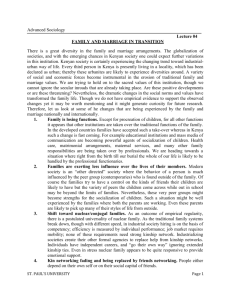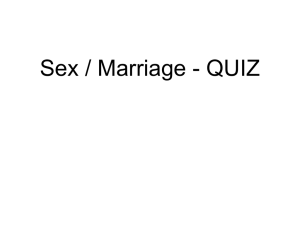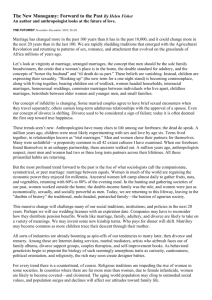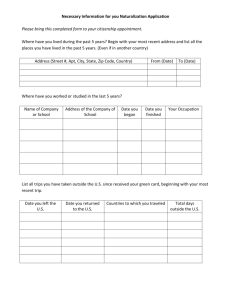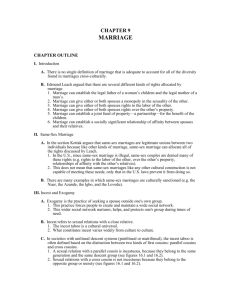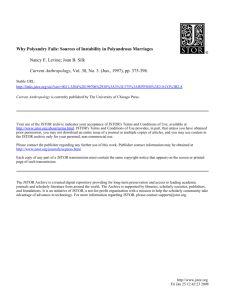marriage
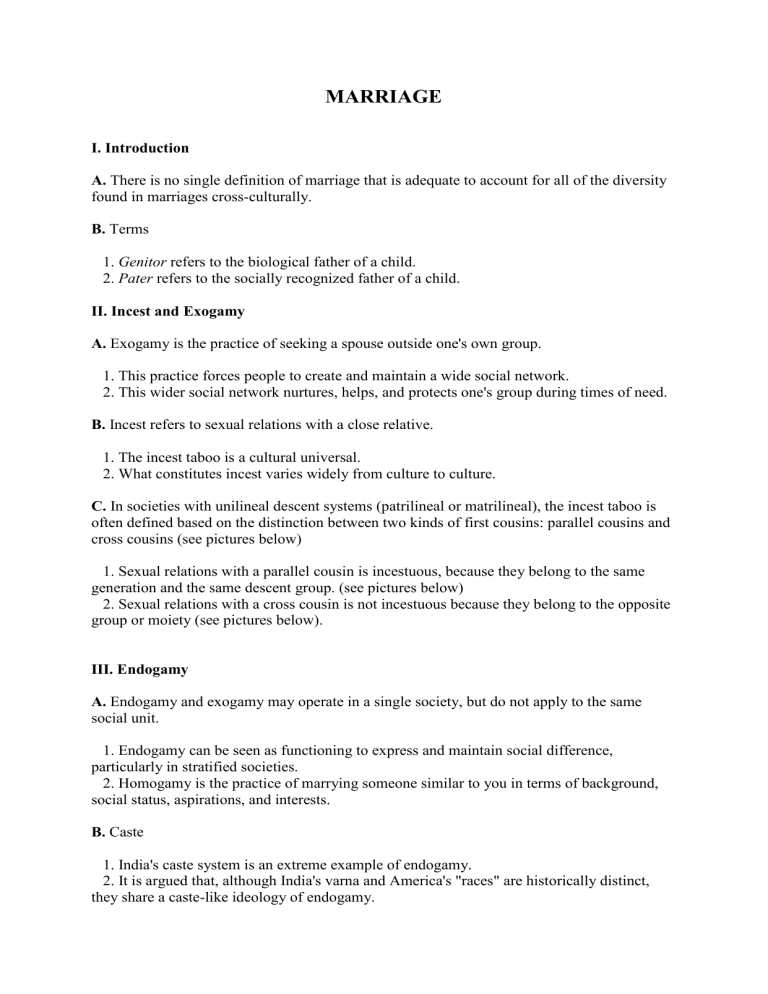
MARRIAGE
I. Introduction
A.
There is no single definition of marriage that is adequate to account for all of the diversity found in marriages cross-culturally.
B.
Terms
1. Genitor refers to the biological father of a child.
2. Pater refers to the socially recognized father of a child.
II. Incest and Exogamy
A.
Exogamy is the practice of seeking a spouse outside one's own group.
1. This practice forces people to create and maintain a wide social network.
2. This wider social network nurtures, helps, and protects one's group during times of need.
B.
Incest refers to sexual relations with a close relative.
1. The incest taboo is a cultural universal.
2. What constitutes incest varies widely from culture to culture.
C.
In societies with unilineal descent systems (patrilineal or matrilineal), the incest taboo is often defined based on the distinction between two kinds of first cousins: parallel cousins and cross cousins (see pictures below)
1. Sexual relations with a parallel cousin is incestuous, because they belong to the same generation and the same descent group. (see pictures below)
2. Sexual relations with a cross cousin is not incestuous because they belong to the opposite group or moiety (see pictures below).
III. Endogamy
A.
Endogamy and exogamy may operate in a single society, but do not apply to the same social unit.
1. Endogamy can be seen as functioning to express and maintain social difference, particularly in stratified societies.
2. Homogamy is the practice of marrying someone similar to you in terms of background, social status, aspirations, and interests.
B.
Caste
1. India's caste system is an extreme example of endogamy.
2. It is argued that, although India's varna and America's "races" are historically distinct, they share a caste-like ideology of endogamy.
C.
Royal Incest
1. Royal families in widely diverse cultures have engaged in what would be called incest, even in their own cultures.
2. Manifest function: the reason given for a custom by its natives.
3. Latent function: an effect a custom has that is not explicitly recognized by the natives.
4. The manifest function of royal incest in Polynesia was the necessity of marriage partners having commensurate mana.
5. The latent function of Polynesian royal incest was that it maintained the ruling ideology.
6. The royal incest, generally, had a latent economic function: it consolidated royal wealth.
D.
Edmund Leach argued that there are several different kinds of rights allocated by marriage.
1. Marriage can establish the legal father of a woman's children and the legal mother of a man's.
2. Marriage can give either or both spouses a monopoly in the sexuality of the other.
3. Marriage can give either of both spouses rights to the labor of the other.
4. Marriage can give either of both spouses rights over the other's property.
5. Marriage can establish a joint fund of property -- a partnership -- for the benefit of the children.
6. Marriage can establish a socially significant relationship of affinity between spouses and their relatives.
IV. Marriage as Group Alliance
A.
Bridewealth
1. Particularly in descent-based societies, marriage partners represent an alliance of larger social units.
2. Bridewealth is a gift from the husband's kin to the wife's, which stabilizes the marriage by acting as an insurance against divorce.
3. Brideprice is rejected as an appropriate label, because the connotations of a sale are imposed; but progeny price is considered an equivalent term.
4. Dowry, much less common than bridewealth, correlates with low status for women.
5. Fertility is often considered essential to the stability of a marriage.
6. Polygyny may be practiced to ensure fertility.
B.
Durable alliances
1. The existence of customs such as the sororate and the levirate indicates the importance of marriage as an alliance between groups.
2. Sororate marriages involve the widower marrying one of his deceased wife's sisters.
3. Levirate marriages involve the widow marrying one of her deceased husband's brothers.
VI. Divorce
A.
Divorce is found in many different societies.
1. Marriages that are political alliances between groups are harder to break up than marriages that are more individual affairs.
2. Payments of bridewealth also discourage divorce.
3. Divorce is more common in matrilineal societies as well as societies in which postmarital residence is matrilocal.
4. Divorce is harder in patrilocal societies as the woman may be less inclined to leave her children who, as members of their father's lineage, would need to stay him.
B.
In foraging societies forces act to both promote and discourage divorce.
1. Promote divorce:
1. Since foragers lack descent groups, marriages tend to be individual affairs with little importance placed on the political alliances.
2. Foragers also have very few material possessions.
2. Discourage divorce:
1. The family unit is the basic unit of society and division of labor is based on gender.
2. The sparse populations mean that there are few alternative spouses if you divorce.
VI. Plural Marriages
A.
Polygamy is illegal in Europe, but Europeans do practice serial monogamy, through multiple marriages and divorces.
B.
Polygyny
1. Even in cultures that approve of polygamy, monogamy still tends to be the norm, largely because most populations tend to have equal sex ratios.
2. Polygyny is more common than polyandry because, where sex ratios are not equal, there tend to be more women than men.
3. Multiple wives tend also to be associated with wealth and prestige (the Kanuri of Nigeria and the Betsileo are used as examples).
C.
Polyandry
1. Polyandry is quite rare, being practiced almost exclusively in South Asia.
2. Among the Paharis of India, polyandry was associated with a relatively low female population, which was itself due to covert female infanticide.
3. Polyandry is usually practiced in response to specific circumstances, and in conjunction with other marriage formats.
4. In other cultures, polyandry resulted from the fact that men traveled a great deal, thus multiple husbands ensured the presence of a man in the home.
Patrilineal moiety organization
Matrilineal moiety organization
